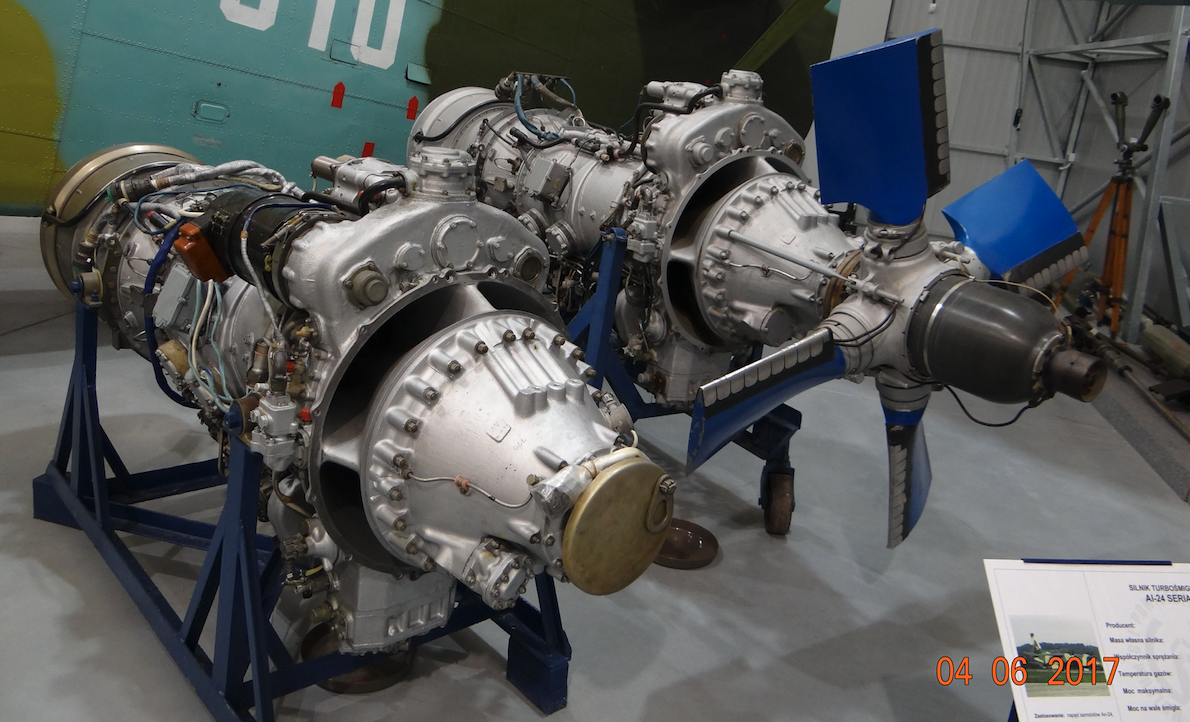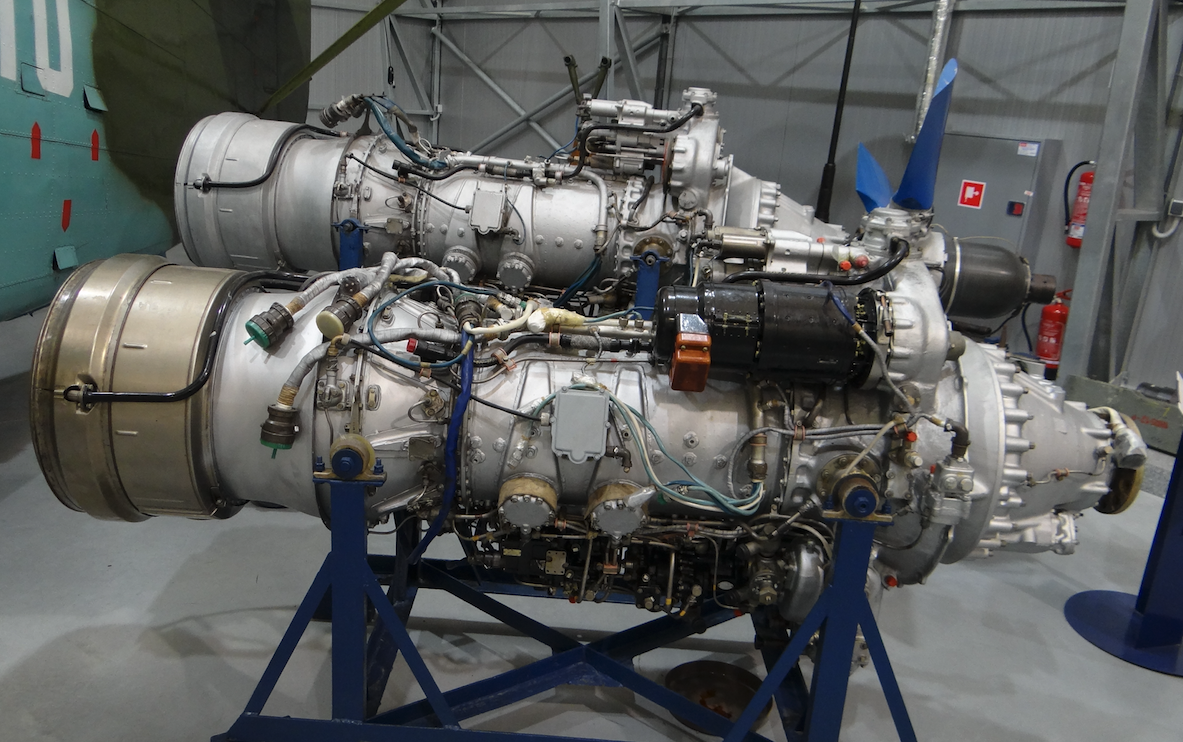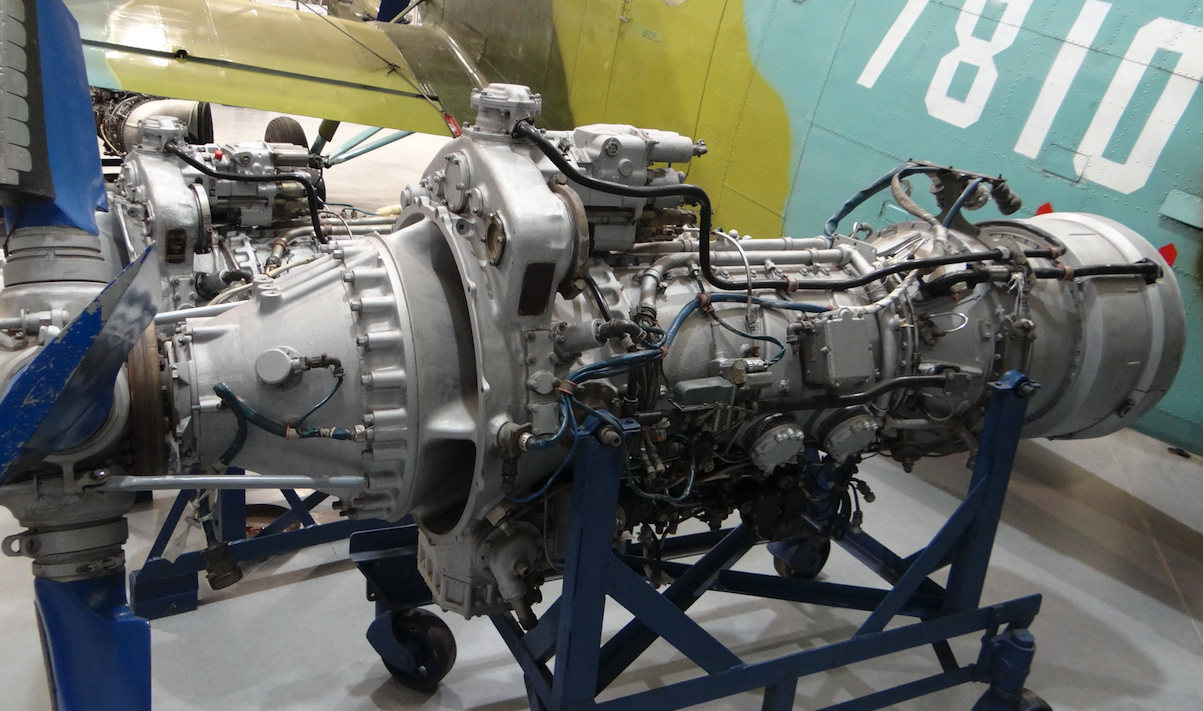Turboprop engine Aleksander Iwczenko AI-24
Aleksander Iwczenko AI-20.
During the 50 years, the CCCP developed several turboprop engines. One of them was the Ivchenko AI-20 engine. This engine was used to power such aircraft as An-10, An-12 and Ił-18. The engine was developed at the end of the 50-year period in Zaporizhia. The team was headed by Alexander Ivchenko. Previously, the team was involved in the development of small piston engines. The AI-20 engine was designed for the new An-10 and Il-18 aircraft. The engine was planned for a momentary power of about 4,000 kW and a constant (cruise) power of 2,090 kW. The competitor of the AI-20 engine was the Kuznetsov NK-4 turboprop engine, which, however, turned out to be worse, and the Kuznetsov team had a more urgent task – the NK-8 turbojet engine for the Il-62 aircraft.
The AI-20 engine is equipped with a 4-blade fixed-speed propeller with a diameter of 4.5 m. The engine is started with an electric starter. Initially, the engine was plagued by faults. The inter-renovation period was 600 hours. This period has been extended to 2,000 working hours. The total engine life was 22,000 hours. The AI-20 engine was produced at the Motor Sich plants in Zaporizhia and Perm. An impressive number of engines of 14,000 were built. The engine was also produced in China. AI-20 engines went to An-8, An-10, An-12, An-32, Be-12, Il-18, Il-38. The engine is relatively loud and the comfort of traveling by IL-18 planes was not high.
AI-20 engine consists of: 10-stage axial compressor with four air valves, combustion chamber consisting of 10 pitcher combustion chambers, 3-stage turbine. Length 3.10 m, maximum height 1.18 m, maximum width 0.84 m, weight 1,040 kg. Power 3 809 kW. Compressor compression was 7.6: 1, and in flight 9.2: 1. The air flow through the engine is 21 kg / s. The temperature in front of the turbine is 900 degrees C.
Aleksander Iwczenko AI-24.
Almost at the same time as the AI-20 engine, the Ivchenko AI-24 engine was being developed. The AI-24 engine was to have a maximum power of 2,000 kW, which is half the power of the AI-20 engine. The first launch of the AI-24 engine took place in 1958. The engine was used to power the An-24, An-26, An-30 aircraft. The AI-24 engines ranged from 1,877 kW to 1,902 kW. They are fitted with 4-blade propellers, adjusted and equipped with a de-icing system, both for the leading edge of the blades and the cap. Serine production started at Motor Sich in Zaporizhia in 1960.
The first production series of engines was short and comprised 100 units. The experience gained was used to start the serial production of the AI-24 Series 2 engines. The most were built of these engines.
Antonow An-24.
When, at the end of 50 years, Antonov’s design bureau developed the An-24 airliner, the AI-24 engine was specially adapted to the aircraft. It was about a ventilation, heating and fire protection system. The first prototype of the new An-24 aircraft was flown on December 20, 1959, with J. Kurlin and G. Łysenko as pilots. In April 1960, the first flight was made by the complete passenger version. In 1963, the aircraft entered service. The production was significant and in 1967, it exceeded 1,100 units. To this number, we need to add a few hundred aircraft made in China, under the designation Y-7.
In 1960, eleven engines marked AI-24V (W) were built, which were used to power the prototype Mil Mi-8 helicopters. The letter "V" in the name of the engine stands for vertalot – helicopter. The AI-24V (W) engine had a power of 2 HP. However, other engines – TW2-117 – were selected for the Mil Mi-8 helicopter, and work on the AI-24V (W) engine was stopped.
Work on the AI-24 engine continued. In 1966, the AI-24A version was developed, which has a maximum thrust of 1,900 kW (2,550 kW). The engine is equipped with a fire-fighting system that can operate automatically.
The AI-24T engine version received a water injection installation, increasing the instantaneous engine power. The engine also features automatic power overload and exhaust gas temperature limitation, as well as vibration monitoring and automatic power limitation.
The AI-24 turboprop engine featured a wide margin of dynamic gas stability under all power conditions, altitude and flight speed. The most notable feature of the engine was its operational reliability. The main advantages of the engine are simple structure, high reliability, long service life and ease of maintenance. The popularity and success of the An-24 aircraft in the socialist countries and China was ensured by the AI-24 turboprop engine.
Four-bladed AV-72T (AW-72T) propeller with constant rotational speed and adjustable angle of attack.
Antonow An-26.
On the basis of the Antonov An-24 passenger plane, a transport plane with a rear loading ramp, the Antonov An-26, was developed. The An-26 aircraft was powered by two AI-24 turboprop engines and, additionally, one RU-19 A-300 turbojet with a thrust of 1 x 8.80 kN (1 x 900 kG). This turbo-jet engine acts as a starter for the main engines, supports the take-off and can also act as a marching engine. RU-19 A-300 is a typical APU and driving motor. The An-26 prototype was flown in 1969.
Engine starting is independent of airport sources. However, in reality engine start-up is performed with the help of airport power sources. During take-off, the failure of one of the engines does not interrupt its continuation. The main engines are the AI-24 T version, with a maximum power of 2 x 2 103 kW.
In 1969, serial production of the Antonov An-26 aircraft was launched. About 1,000 were built. In 1981, an improved version, designated An-26 B, was tested. The aircraft has good flight properties. With a payload of 2,100 kg, it has a range of 2,550 km.
The Antonov An-26 aircraft has had several more variants. The aerophotographic version of An-30 with a glass bow is noteworthy. First flight in 1974. The An-30 aircraft has a glazed nose in which the position of the camera operator-operator is located. The pilot’s cabin was also rebuilt and raised to the top.
The power unit consists of AI-24NT engines with a thrust of 2 x 2 003 kW and a RU-19 A-300 turbojet engine with a thrust of 1 x 8.83 kN.
Engine construction AI-24.
10-stage axial compressor. There are four anti-pump air bleeds in the compressor. The maximum air pressure is 7.05: 1. The air flow through the engine is 14.4 kg / s. Ring-tube combustion chamber with 8 flame chambers. 3-stage turbine. Oil installation with a pressure of 4.4 bar.
AI-24 engine data:
The engine is a turboprop, single-shaft. Maximum power 1,875 kW (2,550 hp). Maximum power at the propeller shaft 1,214 kW (1,650 HP). The maximum air pressure is 9.55: 1 (7.55: 1). The maximum temperature behind the turbine is 750 degrees Celsius. The maximum speed is 15,800 revolutions per minute. Engine length 2,436 m (95.9 in). Maximum engine width 0.677 m. Maximum engine height 1.075 m. Maximum engine weight 600 kg. Specific fuel consumption 0.309 kg / kWxh.
AI-24T engine data (1970):
The engine is a turboprop, single-shaft, with a water injection installation. Maximum power, with water injection, 2,100 kW (2,800 hp) at 15,100 rpm. Maximum power 1,900 kW (2,500 hp) without water injection. 2.436 m (95.9 in) long. Air inlet diameter 0.36 m (14 in). The face of the air intake is 0.1 m2. Engine weight 600 kg (1,300 lb). The fuel is aviation kerosene type JP-1 or similar. Fuel consumption is 0.324 kg / kWxh. The temperature behind the turbine is 550 degrees Celsius. The thrust to weight ratio is 3.52 kW / kg.
Written by Karol Placha Hetman




